
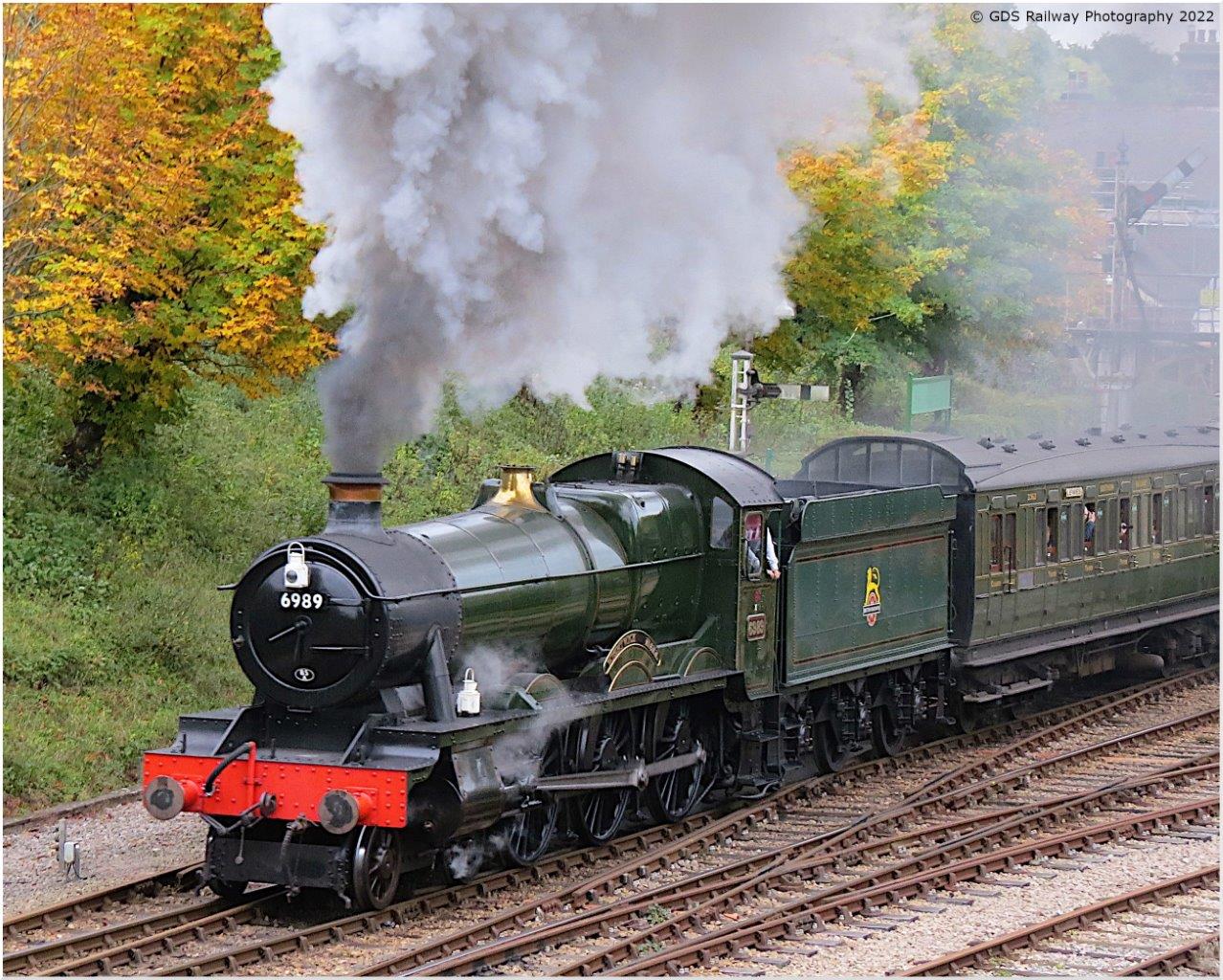)
BR (GWR Design) No. 6989 ‘Wightwick Hall’
- Class: Modified Hall
- Designer: Frederick Hawksworth, a development of Charles Collett’s earlier Hall Class
- Wheels: 4-6-0
- Built: March 1948, Swindon Works
- Withdrawn: June 1964
- Restoration Completed: December 2018
- Returned To Service: 2 March 2019
- Arrived On Bluebell Railway: 23 June 2022
- Owned By: The Quainton Railway Society
In 2018 ‘Wightwick Hall’ became the 150th steam locomotive to have been restored to operational condition after being rescued from Dai Woodham’s famous Barry Scrap Yard in South Wales. This was the culmination of a 41 year restoration by the 6989 Restoration Group.
Arriving on loan to the Bluebell Railway on 23 June 2022, and initially expected to stay until after Giants of Steam that year, its visit has been extended through to late 2024.
‘Wightwick Hall’ spent its working life around Hereford. and Gloucester. After withdrawal it was one of the locomotives saved by being sold on from Barry scrapyard, moving to Quainton Road in January 1978, and restored to operational condition over the following 41 years.
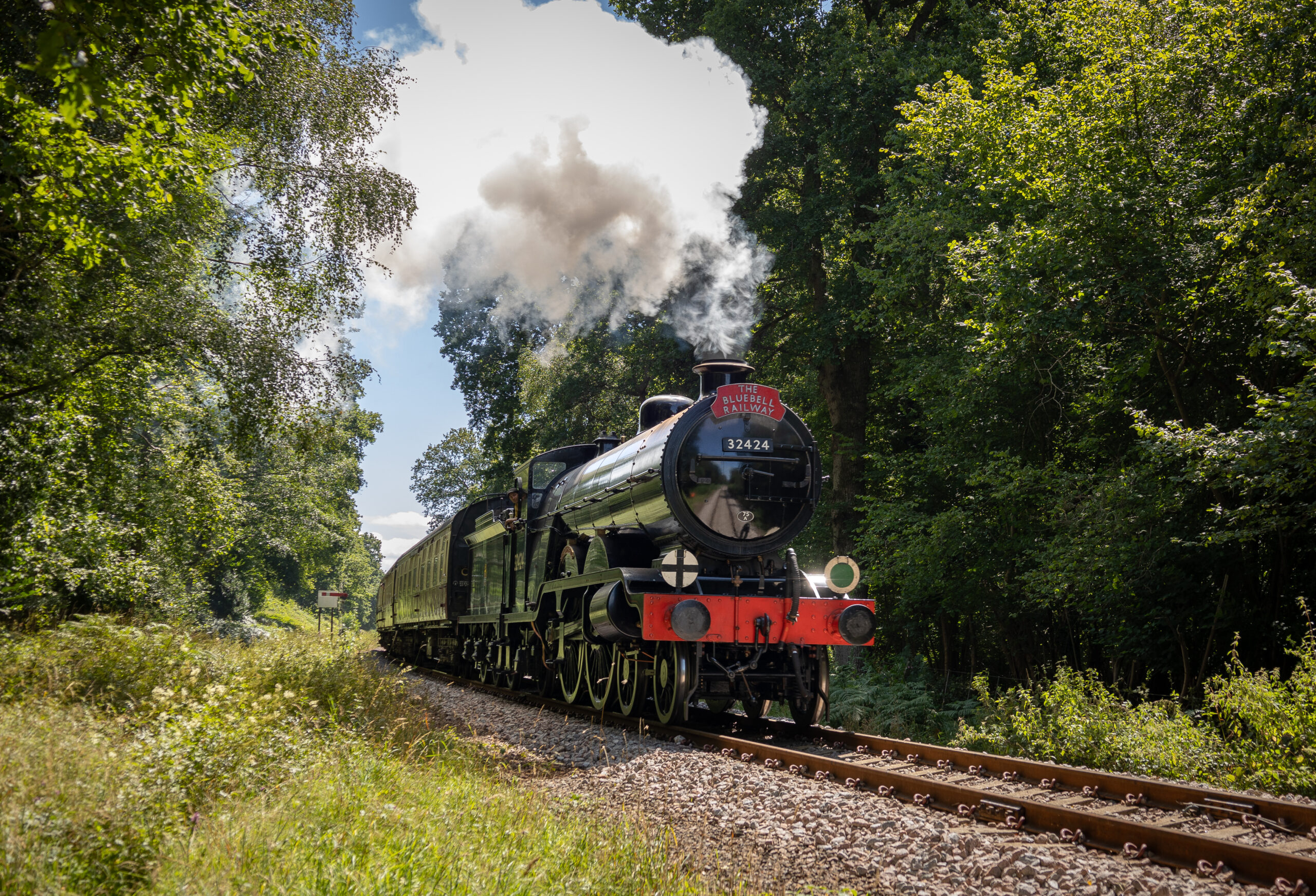)
LBSCR H2-class Atlantic No. 32424 ‘Beachy Head’
- Class: H2
- Designer: Marsh/Billinton
- Wheels: 4-4-2
- Type: Atlantic
- Built: Sept 1911
- Numbers Carried: 424, B424, 2424, 32424
- Withdrawn: April 1958
- Returned To Service: Reconstruction completed and entered service 18 August 2024
- Current Status: Available for service
- Owned By: Bluebell Railway
This magnificent locomotive is the result of our project to reconstruct a Brighton H2 Atlantic based on SR/BR period “Beachy Head”. It is based around a suitable boiler, and includes various other original H2 components have been given to the project, including the locomotive’s original regulator handle and whistle, and a class identification plate. The locomotive was launched into service on the Bluebell on 18 August 2024, the culmination of 24 years work by a dedicated team of engineers, fundraisers and supporters.
The decision to recreate this locomotive, enabled by the discovery of an ex-GNR Atlantic boiler (essentially identical to that used on the H2) in superb condition in a factory in Essex in 1986, is due to the significance of this particular locomotive to the Bluebell itself. It was:
* an iconic Brighton express locomotive;
* the very last Atlantic running in BR service;
* used on many railtours in the 1950s, including several over the Bluebell line;
* this loco’s scrapping in 1958 which led Brighton enthusiasts to realise that action was required to save something of the history of the LB&SCR before it was too late, and led to the first meeting of what became the Bluebell Railway Preservation Society in 1959.
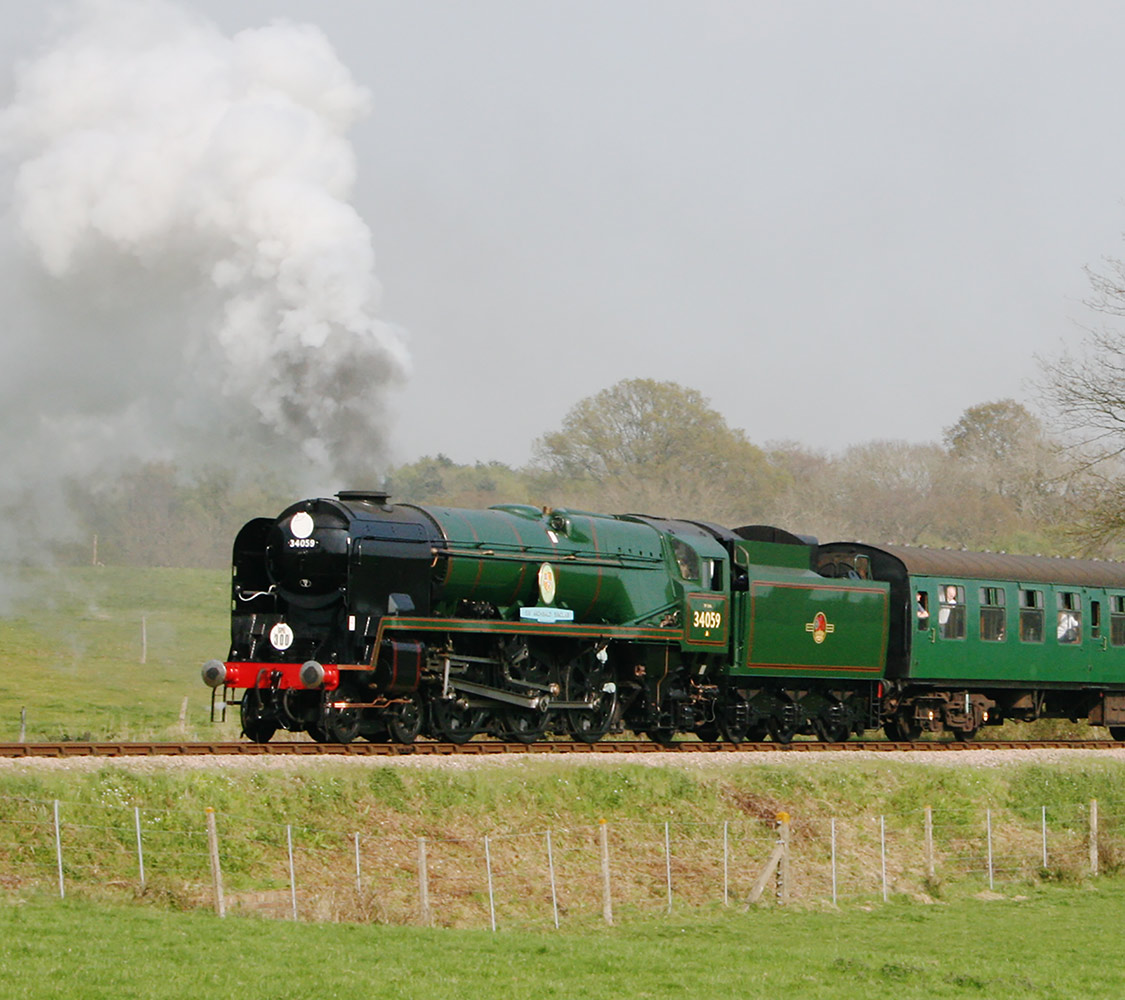)
Rebuilt SR Bulleid Battle of Britain Pacific No. 34059 ‘Sir Archibald Sinclair’
- Class: Battle of Britain (Rebuilt)
- Designer: Bulleid / Jarvis
- Wheels: 4-6-2
- Built: 1947 - Rebuilt 1960
- Numbers Carried: 21C159, 34059
- Withdrawn: 1966
- Last Overhaul Completed: November 2023
- Previously Operational: April 2009 to October 2011
- Owned By: Bluebell Railway
The identical “West Country” and “Battle of Britain” pacifics were built to provide increased power for use on the Southern’s secondary main lines, especially those in the West country with weight restrictions. However, some of Bulleid’s novel ideas, designed to reduce maintenance costs, proved troublesome. Therefore in 1957 a programme of rebuilding the locomotives along conventional lines was started. The rebuilding of the Bulleid light pacifics added several tons to their weight, but produced, to all intents, brand-new locomotives, whilst retaining the distinctive light-weight Bulleid-Firth-Brown wheels and his superb free-steaming boiler, along with many other of the successful innovative design features.
Rescued from Barry scrapyard in 1979 without a tender, this locomotive has since then been the subject of ongoing restoration work and fundraising. A tender underframe was salvaged from a steel-works, the original intention being to use this in conjunction with a new body. However this underframe was in poor condition, and in the end only some fittings from it were used, with the tender frames being constructed at Sheffield Park from new material. A new 5250-gallon tender body has been made, and placed on it.
The formal launch into Bluebell service, as the first rebuilt Battle of Britain to steam in preservation, performed by Viscount Thurso (grandson of Sir Archibald Sinclair, who was the wartime Secretary of State for Air from 1940) on 24th April 2009. Regrettably, the loco was withdrawn during October 2011, in need of further major firebox repairs; the construction of a new firebox has been contracted out, and with the boiler work completed in house, and the frames and tender overhauled, it returned to service in November 2023.
Although the locomotive is owned by the Bluebell Railway, the Battle of Britain Locomotive Group who brought it to the Bluebell from Barry, along with The Bulleid Society, are heavily involved in fundraising and assisting in the overhauls of this locomotive.
)
LBSCR Terrier No. 72 ‘Fenchurch’
- Class: A1
- Designer: William Stroudley
- Wheels: 0-6-0T
- Built: 1872, Brighton Works
- Numbers Carried: 72, B636, 2636, 32636
- Last Overhaul Completed: 10 January 2023
- Previously Operational: February 2001 to 23 January 2011, as No. 672
- Owned By: Bluebell Railway
Stroudley’s famous Terriers survived for decades after more modern designs had been scrapped, working on lightly laid Branch lines. ‘Fenchurch’ was sold to the Newhaven Harbour Company, being light enough to cross a bridge within the docks. It came back into Southern Railway ownership, and continued to work at Newhaven for many years. It came to the Bluebell in 1964, having been for a number of years a celebrity as the oldest locomotive working on British Railways.
In early December 2019 ‘Fenchurch’ entered the Locomotive works, was dismantled to remove the boiler for assessment, and the remainder of the locomotive reassembled for a return to public display in the locomotive shed. Completed in November 2022, an intensive period of running in and testing followed. It is now painted in its original Stroudley Golden Ochre livery. You can see details of this recent overhaul here.
During its 2001 overhaul ‘Fenchurch’ had been converted back to represent its original A1 rather than A1X form and painted as 672 in Marsh Umber, after which it gave ten years of pretty reliable service.
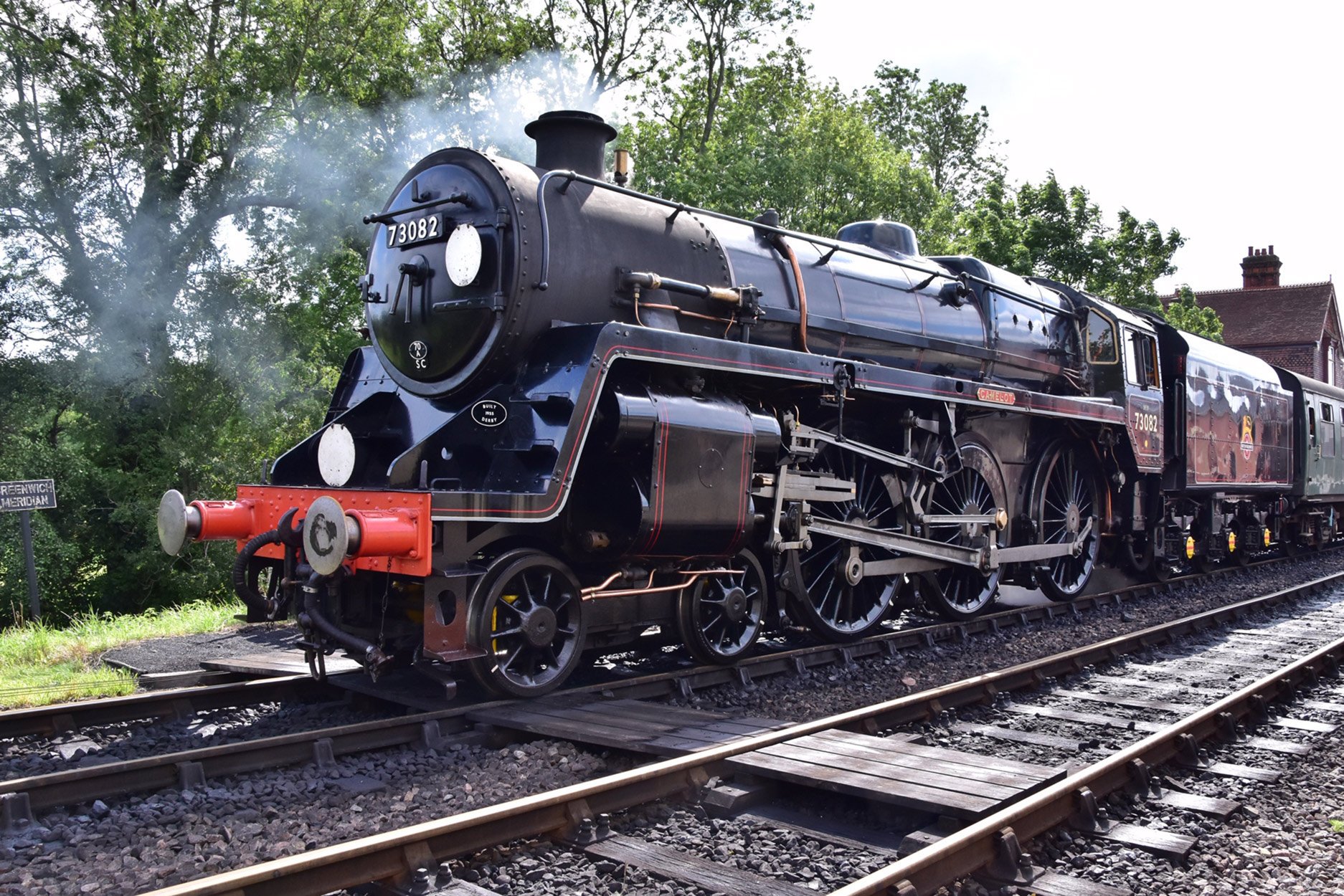)
BR Standard 5MT No. 73082 ‘Camelot’
- Class: 5MT
- Designer: Robert Riddles, with design work done at the ex-LNER Doncaster Drawing Office
- Wheels: 4-6-0
- Built: 1955, Derby Works
- Last Overhaul Completed: September 2021
- Previously Operational: 28 October 1995 – June 2005 & 25 October 2015 – December 2020
- Owned By: The 73082 Camelot Locomotive Society
One of the range of “Standard” locomotives designed for British Railways, the basic design took as its starting point William Stanier’s LMS Black Fives, but with larger wheels and cylinders, and a higher running plate. The first 30 were built between April 1951 and January 1952. No. 73082 was part of a second batch, of 100 locomotives, built 1953-57.
Modern engines with roller bearings, highly capable and easy to maintain, they were withdrawn long before they were worn out thanks to BR’s rush to get rid of steam in the 1960s. ‘Camelot’ was one of the Southern Region’s allocation of Standard 5s, and when the King Arthur class, which they replaced, were being withdrawn, a staff suggestion led to the names being transferred to the new engines.
This locomotive is believed to hold the record for the highest speed for the class, at 107 mph (on Christmas Eve 1964, near Andover). With a late-night parcels train and a driver keen to get home in time for a party, the 36 miles from Salisbury to Basingstoke was completed in 28 minutes start to stop, an average speed of 77.1 mph!
A survivor of Barry Scrapyard, ‘Camelot’ is the only remaining one of the named Standard 5s. It was returned to working order thanks to the dedication of the Camelot Society, which carried out fund-raising and engineering work. The latter included the construction of a brand-new tender body, fitted to frames recovered from a South Wales Ironworks, since, like so many Barry locos, it had lost its tender. It was a core member of the Bluebell’s loco fleet for the decade after it returned to traffic in 1995.
In preparation for its next overhaul, the Camelot Locomotive Society prepared the loco for the boiler lift, major work was undertaken on the wheelsets and the roller-bearings, the boiler received heavy repairs off-site, and the overhaul and painting was completed in October 2015.
To mark 60 years since 73082 was constructed at Derby in 1955 (although relaunched complete with its nameplates at the Giants of Steam weekend in 2015) it ran for the following year without nameplates, to mark this anniversary. ‘Camelot’ received its nameplates at Eastleigh works in August 1959, whilst still carrying the early BR tender emblem, and now carries them again.
At the end of 2020, with the country entering a third Coronavirus lockdown, the opportunity was taken to carry out some remedial work on ‘Camelot’ in the Bluebell’s workshop. A problem had arisen with leaks at the foundation ring rivets, and to allow these to be replaced, the boiler was lifted. Although there were still 4 years remaining on the boiler ticket, while it was out of the frames other work was carried out as necessary, including partial retubing, gaining a new 10 year boiler ticket.
→ Find out more
→ 73082 Camelot Locomotive Society
→ Facebook group
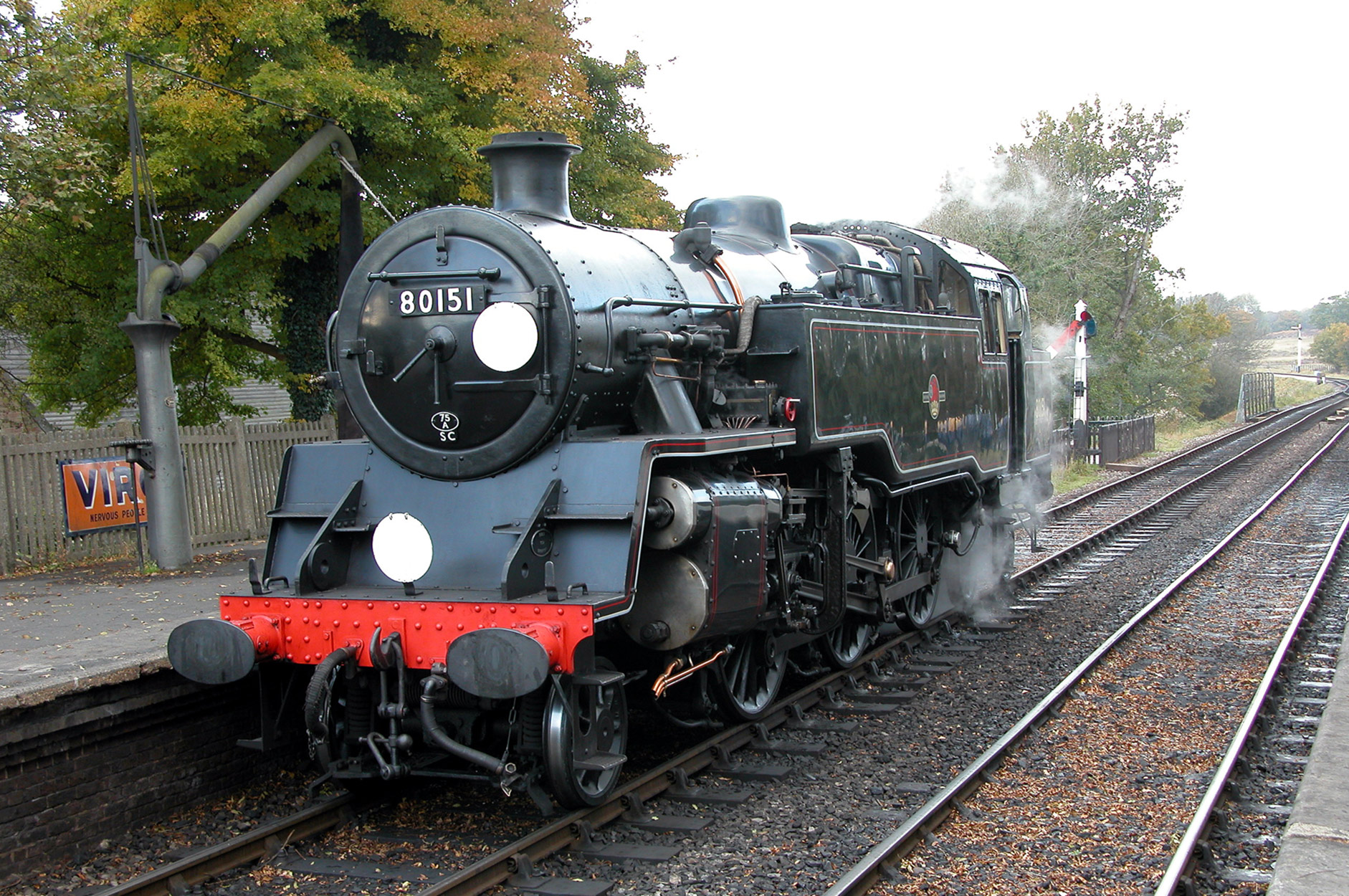)
BR Standard 4MT Tank No. 80151
- Class: BR 4MT
- Designer: Robert Riddles, with design work done at Brighton
- Wheels: 2-6-4T
- Built: 1957, Brighton Works
- Last Overhaul Completed: 27 July 2019
- Previously Operational: Oct 2001 to 19 May 2012
- Owned By: The 80151 Locomotive Company Limited (The Bluebell Railway Trust currently holds 40.3% of the shares in the company)
The 4MT tank locomotives were closely linked to the Bluebell line in the 1950s, and although the last Brighton-built locomotive, No. 80154, which also hauled the final train in 1958, escaped preservation, 80151 itself is known to have worked the line’s services on occasions. A one-time resident of Barry scrapyard, 80151 arrived from another preservation site in 1998 and returned to steam after the completion of its overhaul in the Bluebell’s workshops in October 2001. Quite apart from the close association of the class with the line, they are also the ideal locomotive for our services, and this is one of two such locomotives resident on the Bluebell.
Its latest overhaul, which cost over half a million pounds, saw routine heavy maintenance and boilerwork undertaken in-house, and new tyres fitted to the driving wheels.
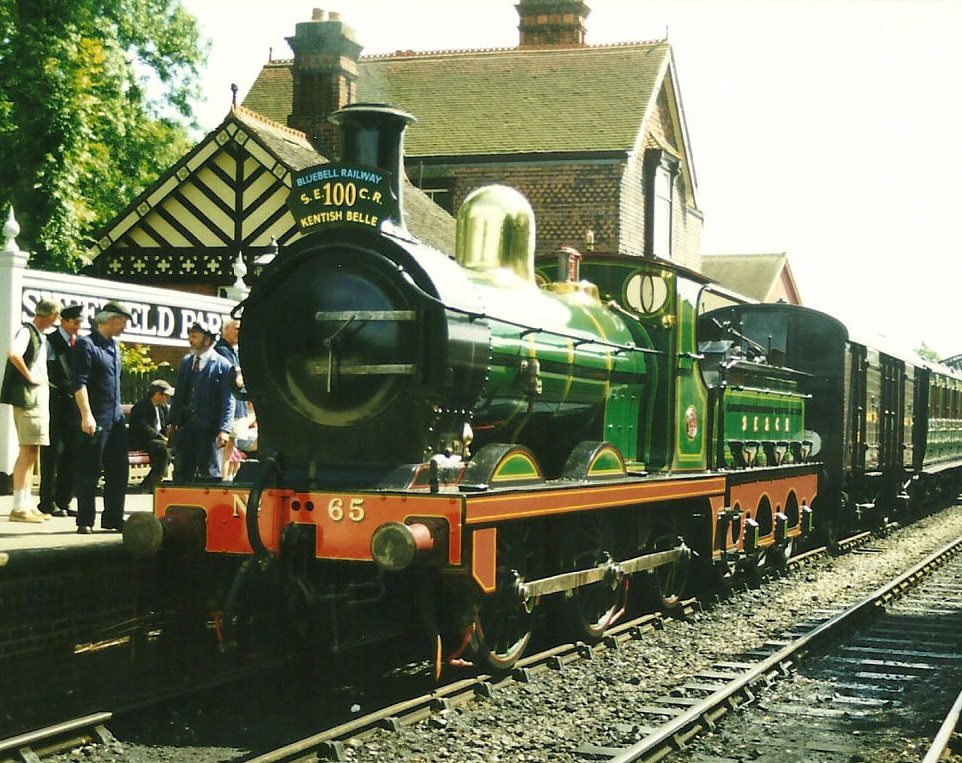)
SECR O1-class No. 65
- Class: SER O, rebuilt by SECR, as O1
- Designer: James Stirling, 1878, rebuilt Harry Wainwright
- Wheels: 0-6-0
- Built: 1896, Ashford Works - Rebuilt 1908
- Numbers Carried: 65, A65, 1065, 31065
- Returned To Service: 15 July 2017
- Previously Operational: 5 August 1999 to 7 July 2009
- Owned By: The Bluebell Railway Trust
Built at Ashford as an ‘O’ class locomotive to a design already 18 years old, it received a rebuild to class ‘O1’ in 1908, and ran on until finally withdrawn in 1961. In 1963 it was obtained by the late Mr Lewis-Evans and kept at Ashford Steam Centre until its closure. For the following 20 years its whereabouts became something of a mystery (with boiler, frames and tender separated) until it was brought back together at the Bluebell Railway for overhaul, and was returned to steam for the centenary of the amalgamation of the SER and the LCDR in August 1999.
0-6-0s were the commonest goods locomotives in this country, and the Bluebell now hosts a sequence of three unique survivors of this type, demonstrating their development through the first half of the 20th century, from the O1 through the SECR C-class to Maunsell’s Q-class built by the Southern Railway. Although designed for goods work, all of these classes found use on passenger trains at times.
The Bluebell’s spare O1/H boiler was overhauled at The Flour Mill workshop, and fitted in place of its previous boiler during the most recent recent overhaul, which took place at Sheffield Park. The locomotive carries the ornate SECR Wainwright goods livery. The locomotive was purchased from the family of the late owner by the Bluebell Railway Trust in December 2021.
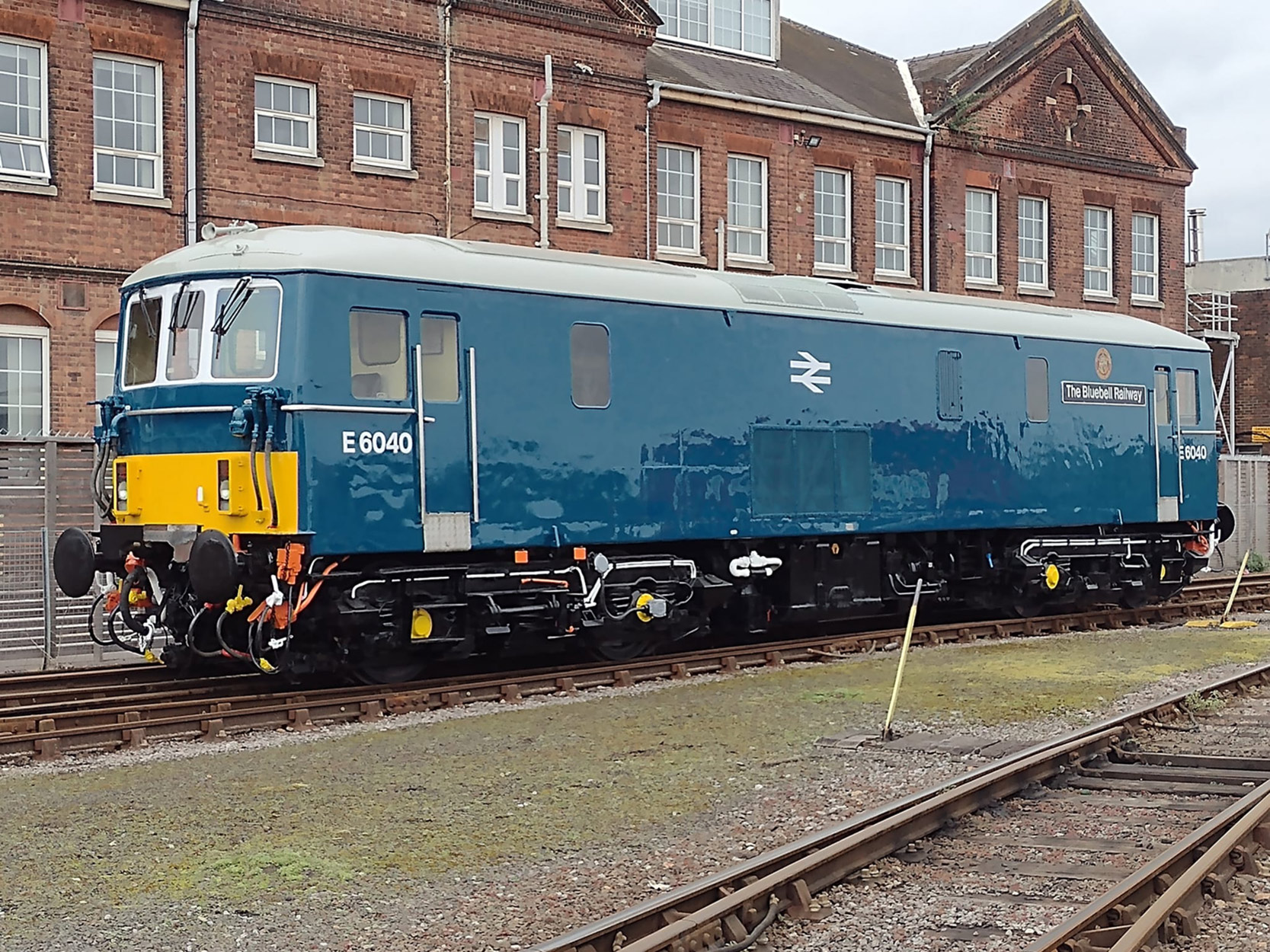)
BR Class 73 (JB) Electro-Diesel E6040 ‘The Bluebell Railway’
- Class: JB (later Class 73/1) Electro-Diesel
- Designer: English Electric
- Wheel Arrangement: Bo-Bo
- Built: 1966, English Electric, Vulcan Foundry
- Numbers Carried: E6040 (was 73133 under TOPS)
- Arrived On Bluebell Railway: 25 April 2023
- Present Location: Bluebell Railway
- Owned By: Private
Known latterly as Class 73s, these were electric locomotives for the Southern Region’s third-rail system, but incorporating a 600 hp diesel engine, similar to those used in the Southern Region’s DEMUs, intended for use in sidings and other non-electrified areas. Six prototypes, the ‘JA’s, were designed and built at Eastleigh in 1962 using English Electric equipment. They were built to the narrow ‘Hastings Gauge’, giving universal track access across the region.
43 more Electro-diesel Locomotives, ‘JB’s in Southern Region classification, were ordered from English Electric, built between 1965 and 1967, as part of the fleet to operate the newly electrified Waterloo-Southampton/Bournemouth line. Initially numbered E6007-E6049, they differed slightly from the ‘JA’s, most notably having higher tractive effort and a 90mph maximum speed.
73133 (as E6040 had become in 1973) was named ‘The Bluebell Railway’ in September 1990, and ran onto what is now Bluebell property two years later at the ceremony passing ownership of the viaduct at East Grinstead to us.
The locomotive just escaped being scrapped in 2004, entered preservation, but returned to main-line use in 2013 and having been used as a shunter at Bournemouth Depot and more recently at Eastleigh Works, was privately purchased from there in December 2022 by a member of the Bluebell Railway’s locomotive department. It was refurbished at his expense at Eastleigh Works in early 2023, prior to moving to the Bluebell Railway.
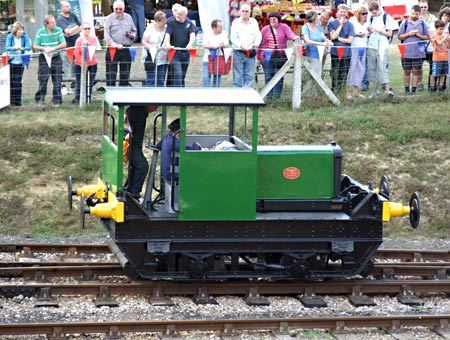)
Howard Petrol-engined Locomotive
- Class: 2-speed 7 ton Main Line Loco
- Wheel Arrangement: 4w, chain driven, maximum speed 8mph
- Built: 1926 by James & Frederick Howard Ltd, Britannia Iron Works, Bedford
- Returned To Service: August 2010
- Arrived On Bluebell Railway: March 1965 (Used on Bluebell until 1969)
- Operated: 1926-1965
Built by Howards in 1926, No 957 was used to shunt their agricultural implement and railway wagon factory sidings in Bedford. The Britannia Iron & Steel Works Ltd took over the site in 1932 to make pipe fittings and continued using it until a larger shunting loco was obtained in 1965. Through the intervention of a local enthusiast the company presented 957 to the Bluebell Railway where it was used for light shunting until about 1969. Under the auspices of the Alf Brown Group an overhaul (details of which are here) was begun in the 1970s at Horsted Keynes which had to include new wheelsets, and it made its debut at the 50th Anniversary Gala in August 2010.
Although nominally operational, at the present time more work is required to complete the restoration of the locomotive.
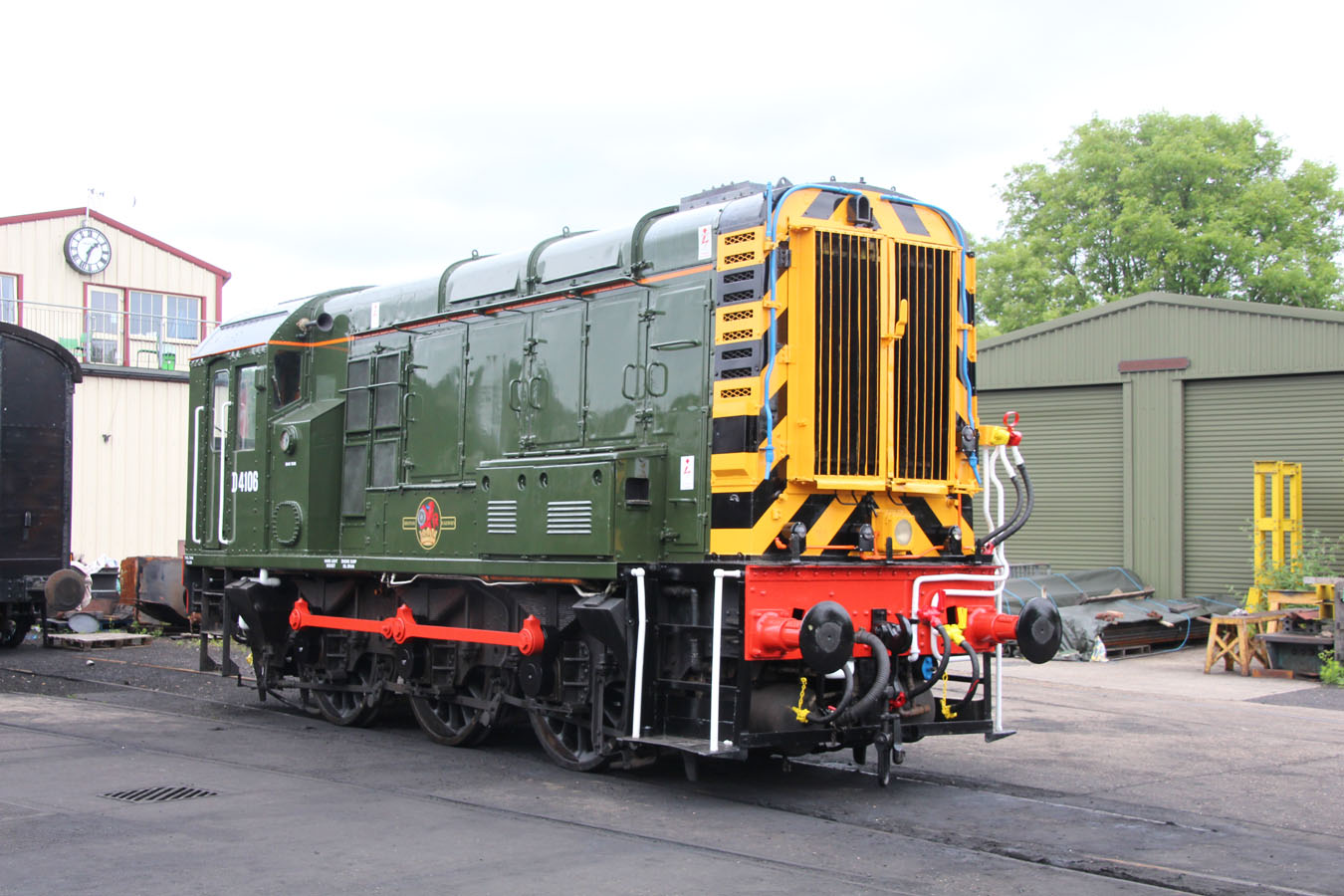)
BR Class 09 Diesel Shunter D4106
- Class: Class 09 Diesel Shunter
- Designer: BR
- Wheel Arrangement: 0-6-0 DE
- Type: BR 350 HP Diesel Shunter
- Built: 13 November 1961, Horwich Works
- Numbers Carried: D4106, 09018
- Arrived On Bluebell Railway: 23 April 2013
- Current Status: Operational
- Owned By: B350 Ltd
The 09 class of diesel-electric shunters were a Southern Region version (of which only 26 were built) of the ubiquitous 08 class of 350HP Diesel shunting locomotives, geared for higher speeds. D4106 was built at British Railways’ Horwich Works on 13 November 1961. It was renumbered as 09018 on 31 December 1973.
No. 09018 was purchased in 2013 by a consortium of Bluebell members who have set up a company to manage the loco, which is hired by the Railway as and when it is needed. On the Bluebell it initially retained HNRC orange and grey livery, with the lettering removed, since the priority was the acquisition of a pool of spare parts, but has now been repainted appropriately.
Photo: D4106 at Sheffield Park on 8 June 2017, following its repaint into its original BR green livery as D4106 (Tony Sullivan)
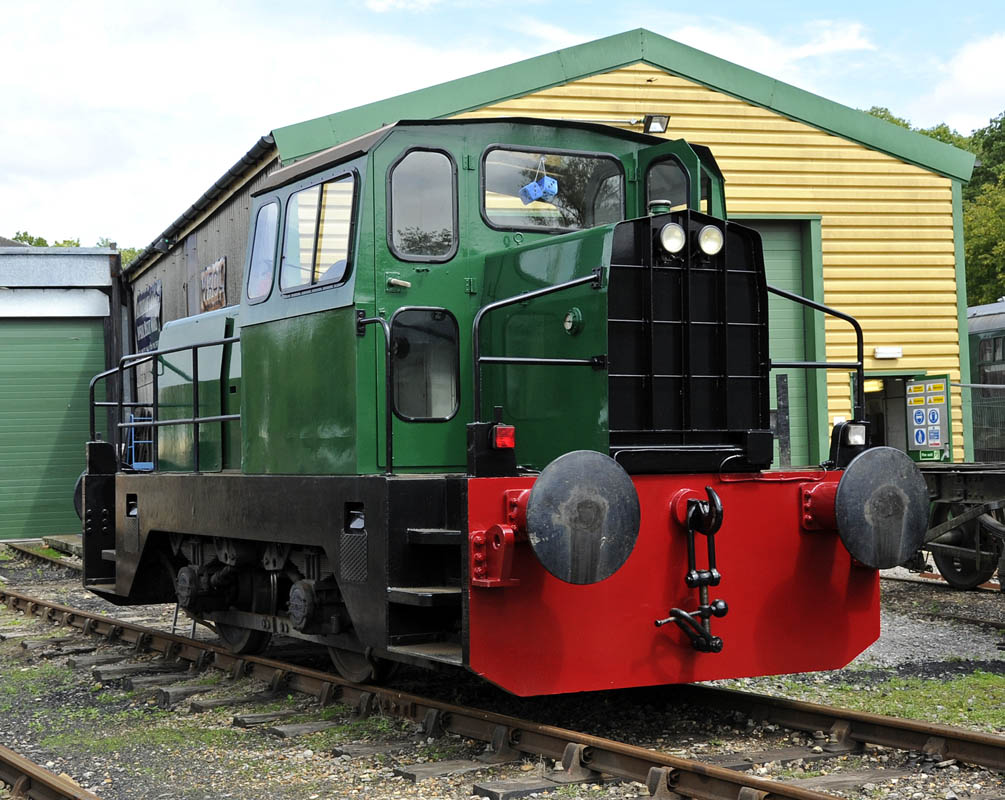)
Sentinel/Rolls-Royce/Thomas Hill 4-w Diesel-Hydraulic loco No. 10241
- Designer: Sentinel
- Wheel Arrangement: 4w DM
- Built: Rolls Royce, 1966
- Numbers Carried: Rolls Royce works No.10241, Manchester Ship Canal DH27, NCB D24, rebuilt Thomas Hill (their works No.247C)
- Arrived On Bluebell Railway: 7 May 2010
- Current Status: Operational (restricted to Horsted Keynes)
- Owned By: Bluebell Railway
Acquired by the Bluebell Railway’s C&W department mainly for shunting work around the carriage yard, this loco arrived on 7th May 2010, in working order.
A Sentinel designed loco, this one was built after the company became known as Rolls-Royce and is their No. 10241 of 1966. However, the loco was rebuilt by Thomas Hill (Rotherham) in 1973 (who had by then acquired the Sentinel/Rolls-Royce locomotive business), becoming their No. 247V.
Photo: 10241, as painted green on the Bluebell, in the yard at Horsted Keynes, 13 August 2011 – Derek Hayward

